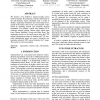Free Online Productivity Tools
i2Speak
i2Symbol
i2OCR
iTex2Img
iWeb2Print
iWeb2Shot
i2Type
iPdf2Split
iPdf2Merge
i2Bopomofo
i2Arabic
i2Style
i2Image
i2PDF
iLatex2Rtf
Sci2ools
91
Voted
ISMIR
2005
Springer
2005
Springer
Rhythm-Based Segmentation of Popular Chinese Music
We present a new method to segment popular music based on rhythm. By computing a shortest path based on the self-similarity matrix calculated from a model of rhythm, segmenting boundaries are found along the diagonal of the matrix. The cost of a new segment is optimized by matching manual and automatic segment boundaries. We compile a small song database of 21 randomly selected popular Chinese songs which come from Chinese Mainland, Taiwan and Hong Kong. The segmenting results on the small corpus show that 78% manual segmentation points are detected and 74% automatic segmentation points are correct. Automatic segmentation achieved 100% correct detection for 5 songs. The results are very encouraging.
Automatic Segment Boundaries | Automatic Segmentation | Information Retrieval | ISMIR 2005 | Segmentation Points |
| Added | 27 Jun 2010 |
| Updated | 27 Jun 2010 |
| Type | Conference |
| Year | 2005 |
| Where | ISMIR |
| Authors | Kristoffer Jensen, Jieping Xu, Martin Zachariasen |
Comments (0)

